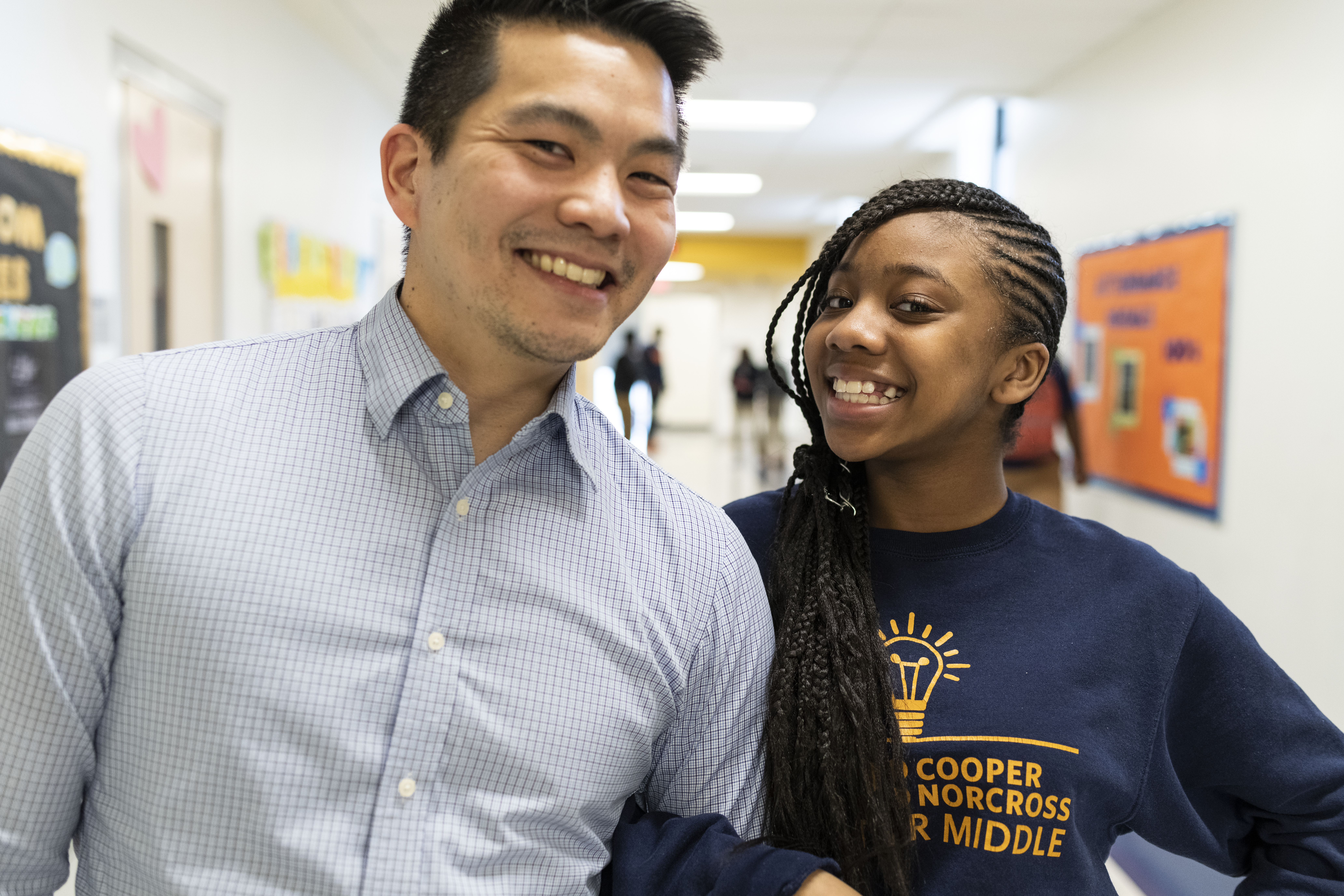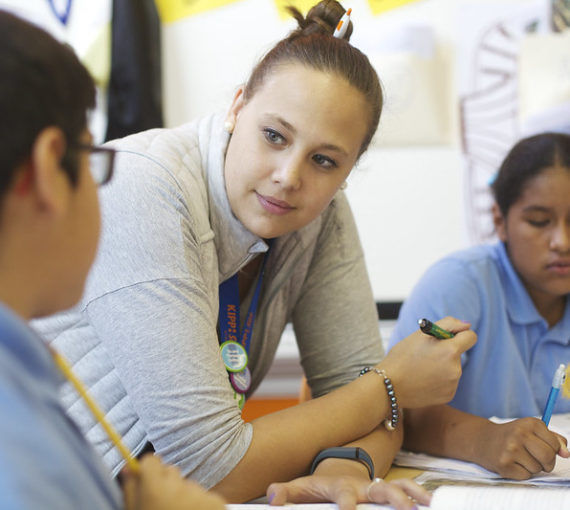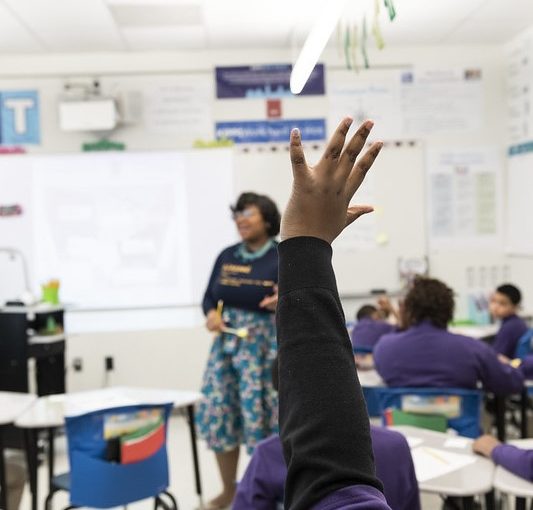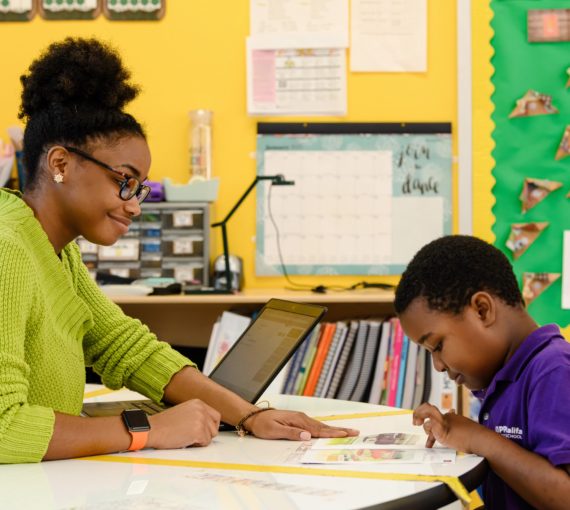Enseñanza sobre justicia social y equidad (en inglés)
-
Lecciones
-
Noticias
Noticias
Teachable Moments Current Issues Lessons | Grades: K-12 Teachable Moment, a project of Morningside Center for Teaching Social Responsibility, fosters social responsibility by sharing classroom lessons, activities and ideas with educators.
The Lowdown: Connecting Newsroom to Classroom | Grades: K-12 KQED offers lesson plans, videos, maps, infographics, and more to help teachers bring the current events into their classroom.
Newsela | Grades: 2-12 Newsela provides teachers, parents, and students with over 1,000 current event articles scaled at five different Lexile reading comprehension levels.
Listenwise: Current Events Podcasts for the Classroom | Grades: 5-12 Listenwise’s collection of podcasts and public radio keeps teaching connected to the real world and builds student listening skills at the same time
CNN 10 (Formerly CNN Student News)| Grades: 6-12 CNN 10 s is a ten-minute, commercial-free, daily news program designed for middle and high school classes.
New York Times The Learning Network: Current Events | Grades: 6-12 NYT Learning Network’s spotlight on articles, activities and questions you can use to bring current events into your classroom.
Teaching the News (Economic Lessons) Newsela | Grades: 9-12 The Council for Economic Education provides resources to put economic lessons in real-life perspective and help educate your students on how to critically engage with current events.

-
Raza
Raza
Teaching Tolerance: Race and Ethnicity | Grades: K-12 Access more than 80 classroom lessons and activities on the topics of race and ethnicity from Teaching Tolerance.
ADL Lesson Plans: Race & Racism | Grades: K-12 The Anti-Defamation League features lesson plans and activities for elementary, middle, and high school students on topics relating to racism and bias.
Five Minute Film Festival on Race & Stereotypes | Grades: K-12 A collection of film clips (compiled by Edutopia) to start conversations about race and stereotypes.
Teaching for Change | Grades: K-12 A collection of social justice teaching resources, including recommended articles, readings, and films on topics like anti-bias education, Civil Rights, music, and Haiti.
Zinn Education Project | Grades: K-12 Drawn from A People’s History of the United States, this site offers a collection of history lessons and materials searchable by theme, time period, and grade. Themes include lessons relating to African-American, Asian-American, Latino, and Native American experiences.
Partners Against Hate | Grades: 6-8 Middle school lessons on building community and combating hate.
Black Lives Matter at School | Grades K-12 A resource guide of downloadable lessons to challenge racism, oppression and build a healthy classroom.

-
Sexualidad
Sexualidad
GLSEN: LGBT-Inclusive Curriculum | Grades: K-12 This curriculum is designed to help teachers ensure LGBT students see themselves reflected in lessons and encourage respectful behavior and critical thinking.
Teaching Tolerance: Gender Expression | Grades: K-12 Access lesson plans and activities on gender expression from Teaching Tolerance.
Teaching Tolerance: Sexual Orientation | Grades: K-12 Access lesson plans and activities on sexual orientation from Teaching Tolerance.

-
Inmigración
Inmigración
Teaching Tolerance: Immigration | Grades: K-12 Teaching Tolerance offers lesson plans and activities on immigration for students.
Facing History: Global Immigration | Grades: K-12 Issues of identity and belonging are inseparable from the experience of immigration. This collection of classroom resources includes stories of immigrants, past and present, illuminating the human lives behind the ever-shifting global landscape we inhabit today.
PBS LearningMedia: Immigration | Grades: K-12 PBS LearningMedia offers teachers more than 100,000 videos, images, interactives, lesson plans, and articles drawn from critically acclaimed PBS programs such as Nova, Frontline, American Experience, and Sid the Science Kid and from expert content contributors like The National Archives and NASA.
Scholastic Resources: Immigration | Grades: K-12 Browse more than 350 lesson plans and resources, divided by grade level, teachers can use to engage students on the topic of immigration.
Coming to America: Immigration Builds a Nation | Grades: K-12 This list of resources, compiled by Education World is designed to introduce students to the two major waves of immigration that brought 34 million people to US shores.
Library of Congress’s Lesson Plans on Immigration | Grades: 3-12 The Library of Congress presents a series of lesson plans, created by teachers for teachers, to explore immigration.
PBS’s The New Americans Lesson Plans | Grades: 7-12 Lesson plans aligned with national academic performance standards, give students hands-on opportunities to grasp the essence of immigration to the United States, from analyzing factual data to conducting oral histories of first or second-generation immigrants.

-
Pobreza
Pobreza
United Nations Global Goals: No Poverty | Grades: K-12 Access lesson plans, posters, and other resources aligned with the UN Global Goal of ‘No Poverty.’
Center Stage: Focus on Poverty | Grades: 6-8 Students will be engaged in reflections of stereotypes, prejudice, and discrimination related to socio-economic status. From a cognitive and affective perspective, students will be involved with activities to assist them in developing sensitivity to working in direct service projects with individuals who are impoverished or disadvantaged in their socio-economic standing.

-
Capacidad
Capacidad
Friends Who Care: Disability Awareness Curriculum | Grades: K-6 This educational program gives students the opportunity to learn what is involved when someone has a disability and how they adapt to live life, go to school, or work as independently as possible.
Teaching Tolerance: Understanding Disabilities | Grades: K-12 Access this collection of lesson plans and activities compiled by Teaching Tolerance to help integrate disability awareness into your classroom.
Student’s Corner: Organization for Autism Research | Grades: K-12 Access stories, videos, and volunteering ideas related to students on the autism spectrum.
Disability Awareness Activity Packet | Grades: K-12 This booklet gives educators some ideas for helping students in the classroom understand different types of disabilities.
Disability History Posters [Smithsonian] | Grades: K-12 Download free posters in English and Spanish relating to the Smithsonian exhibit “EveryBody: An Artifact History of Disability in America.”

-
Noticias
-
Desarrollo Docente
-
Noticias
Noticias
Useful Stuff: Current Events and Social Justice in the Classroom Learn how KIPP-NYC College Prep HS is making the move towards integrating social justice into its instruction.
Why Teach Current Events? Research indicates that a regular dose of current events has a multitude of benefits! This Education World resource includes activity ideas and Internet resources for teaching current events.
Three Tips for Current-Event Lesson Plans Lesson planning can feel overwhelming, but gaining the ability to quickly assess a current event and its relation to social justice and your classroom is worth it.
50 Ways to Teach with Current Events The New York Times presents 50 ideas to help teachers bring current events into the classroom, grouped by category.
Five Tips for Teaching Current Events to Younger Students Talking with children about current events is important because it provides a way to build compassion and critical thinking and, at the same time, address their most important questions.
Difficult Dialogues This guide, from Vanderbilt’s Center for Teaching, seeks to help teachers feel more confident leading difficult dialogues by encouraging reflection on how such discussions connect with larger learning goals, and by providing specific strategies and resources that teachers can use to create more productive conversations in their classrooms.
The Trump Effect: The Impact of the Presidential Campaign on Our Nation’s Schools Ninety percent of educators report that school climate has been negatively affected by the 2016 election, and most of them believe it will have a long-lasting impact.

-
Raza
Raza
Understanding Prejudice: Tips for Elementary School Teachers This page contains tips on how to create a diverse, multicultural, and inclusive class environment, with specific suggestions on how to teach about prejudice and how to handle students who display discriminatory behavior.
Black Students’ Lives Matter: Building the School-to-Justice Pipeline The Black Lives Matter movement inspires us to fight the school-to-grave pipeline as an example of structural racism, after decades in which anti-racism has been defined in excessively personal terms through anti-bias or diversity training.
Connecting to Teach Social Justice and #BlackLivesMatter Educators have always helped young people understand and make meaning of current events.Digital tools give today’s youth the chance to talk back in a new way—at a new volume and magnitude that’s already making history.
Easy Ways to Have Tough Talks with Kids about Race While we may think that we’re protecting kids by not talking to them about race, silence actually does more harm than good. Here’s what one expert says about how to meaningfully talk to kids about racial justice.
Raising Race Conscious Children Use these conversations to dismantle the color-blind framework and prepare young people to work toward racial justice. Many of the blog posts are geared toward white people but a community of guest bloggers represent diverse backgrounds, and the strategies discussed may be helpful for all.
Talking about Race: This website provides content and resources to better understand racial inequity. By equipping teachers with the context and methods necessary to help students be more racially conscious.

-
Sexualidad
Sexualidad
Supporting LGBTQ Students: Resource Roundup: This roundup contains curated resources from within and outside of KIPP focused on supporting all students. These include suggested library books for all ages, suggested training for staff, and other best practices.
Best Practices: Creating an LGBT-Inclusive School Climate: Studies have shown that creating a supportive environment for LGBT students improves educational outcomes for all students, not just those who may identify as LGBT.
Trevor Project: Lifeguard Workshop: This workshop video helps educators assist young people in identifying the challenges faced by LGBTQ people, recognize the warning signs of suicide, and respond to someone who may be in crisis.
Some Considerations When Working with LGBT Students of Color: When working with LGBT students of color1, there are a number of additional concerns that should be taken into consideration. It is crucial to see students through a holistic lens, one that recognizes and tries to understand the complex identities and experiences that shape each individual.
The Educator’s Guide to LGBT Pride: Every year, in the month of June the LGBT community celebrates Pride Month. While including positive representations of LGBT history and people in the curriculum is most effective when it is regular practice, June provides an opportunity to connect topics with current events and celebrations.

-
Inmigración
Inmigración
Post-Election: What Educators Can Do to Support Undocumented Students: This guide from E4FC provides concrete examples of actions you can take—on an institutional level, alongside students, and as an individual—to protect undocumented students, increase support services, and ensure college access and graduation.
Resources 101: Important Info for Immigrants & Allies: Whether you are an immigrant or an ally, stay informed and find crucial and carefully curated information collected by Informed Immigrant. (Choose “Information for Educators and Schools.”)

-
Pobreza
Pobreza
How Poverty Affects Classroom Engagement: ASCD identifies even differences between middle-class and low-income students show up at school. By understanding those differences and how to address them, teachers can help mitigate some of the negative effects of poverty.
Overcoming the Challenges of Poverty: ASCD shares a list of 15 things educators can do to make our schools and classrooms places where students thrive.
Educating Students Who Live In Poverty: Review the different meanings of poverty, five research-based theories on helping people move out of poverty, and the correlating best practices for educating students and connecting with families.
Building a Pedagogy of Engagement for Students in Poverty: Paul Gorski addresses how educators can still take many research-proven steps to foster equality of opportunity in education.
Children of Poverty Deserve Great Teachers: In this report, the NEA recommends policy actions for attracting and retaining accomplished teachers that can make a difference in the teaching and learning experience in high-needs schools.

-
Capacidad
Capacidad
Creating Positive School Experiences for Students with Disabilities: This article provides an overview of factors to consider in creating positive school experiences for students with disabilities and suggestions for intervention efforts.
The General Ed Teacher’s Guide to the Inclusive Classroom: This guide contains advice and resources on helping students meet their goals and reach students with diverse abilities and skill bases.
Teacher’s Corner: Organization for Autism Research: Access collections of resources dedicated to learning more about autism and supporting students on the spectrum in your classroom.
Special Education Subject Center: Here, you will find information and tools, from Education World and other valuable sources, chosen specifically for the special education community.
10 Questions About Why Ableist Language Matters, Answered: Learn why ableist speech matters and the top questions people have about incorporating it into their daily lives.
10 Tips for Teaching About Invisible Disabilities and Bullying: Teachers can play a critical role in bullying prevention by encouraging a culture of acceptance through discussion and classroom activities.
What Are Classrooms Like for Students with Learning Disabilities?: Classrooms can be perilous in a number of ways for students with learning disabilities. Here are some tips to remember when working with students with learning disabilities.

-
Noticias
Conozca a los profesores KIPP
Diversidad en KIPP
Estamos comprometidos a crear una organización diversa e incluyente. Nuestra fuerza y resolución, nuestra salud como equipo y familia, nuestra productividad y efectividad y la calidad de las decisiones que tomamos, todo eso está arraigado en nuestra diversidad. Así que nos esforzamos por crear un ambiente en el que cada miembro de nuestro equipo pueda llevar al trabajo la totalidad de su identidad y experiencia.



